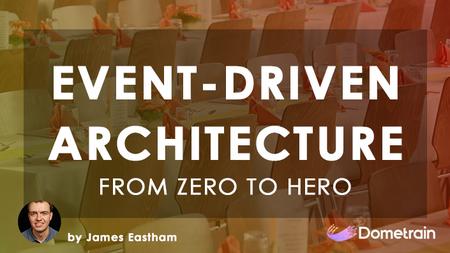English | MP4 | AVC 1920×1080 | AAC 44KHz 2ch | 62 Lessons (5h 30m) | 1.85 GB
Learn everything you need to start using Event-Driven Architecture
Event-driven architecture is considered to be the holy grail of system design in many ways. Its design is based on events, which are actions around which we can build reactive systems. This leads to asynchronous, decoupled, persistent, fault-tolerant and scalable systems. In this course, Datadog Developer Advocate (ex AWS) James Eastham will assume no prior knowledge of EDA and teach you the fundamentals as well as advanced concepts on understanding, implementing and testing Event-Driven Architecture systems.
Table of Contents
1 Welcome
2 What will you learn in this course
3 Who is the course for and prerequisites
4 Introduction
5 Coupling; The silent killer of distributed systems
6 What is an event
7 Event-driven vs event-based
8 Types of events
9 Microservics vs event-driven architecture
10 Event storming
11 Building blocks of event-driven systems
12 Stream, queue or bus. What’s the difference
13 Pros & Cons of Event-Driven Systems
14 Introduction (2)
15 Responsibilites as a producer
16 Publishing your first event
17 Public vs private events
18 The outbox pattern, part 1
19 The outbox pattern, part 2
20 Schema design and event structure
21 Summary
22 Introduction (3)
23 Responsibilities as a subscriber
24 Build your first subscriber
25 Naively implementing idempotency
26 Handling errors
27 Summary (2)
28 Introduction (4)
29 Demo Application Overview
30 Storage-first API’s
31 Technology choices for this course
32 Front-end communication in an async world
33 Thin events & smarter callbacks
34 Idempotency – done better
35 Versioning events and evolvability
36 Handling failures
37 Summary (3)
38 Introduction (5)
39 Orchestration vs choreography
40 Orchestration in action
41 Commands can be asynchronous too
42 Reversing actions with the Saga pattern
43 Technology choices for building orchestrators
44 Trade-offs of Orchestration vs choreography
45 Introduction (6)
46 Distributed tracing + context
47 Semantic conventions for messaging
48 Understanding dependent systems
49 Span links vs trace propagation
50 Are metrics important
51 Documenting your event-driven system
52 Summary (4)
53 Introduction (7)
54 Challenges with testing EDA
55 Integration tests in practice
56 SchemaContract testing
57 Testing for failure
58 Testing for idempotency
59 Summary (5)
60 Deploying event-driven systems
61 EDA in legacy systems
62 Next steps
Resolve the captcha to access the links!
